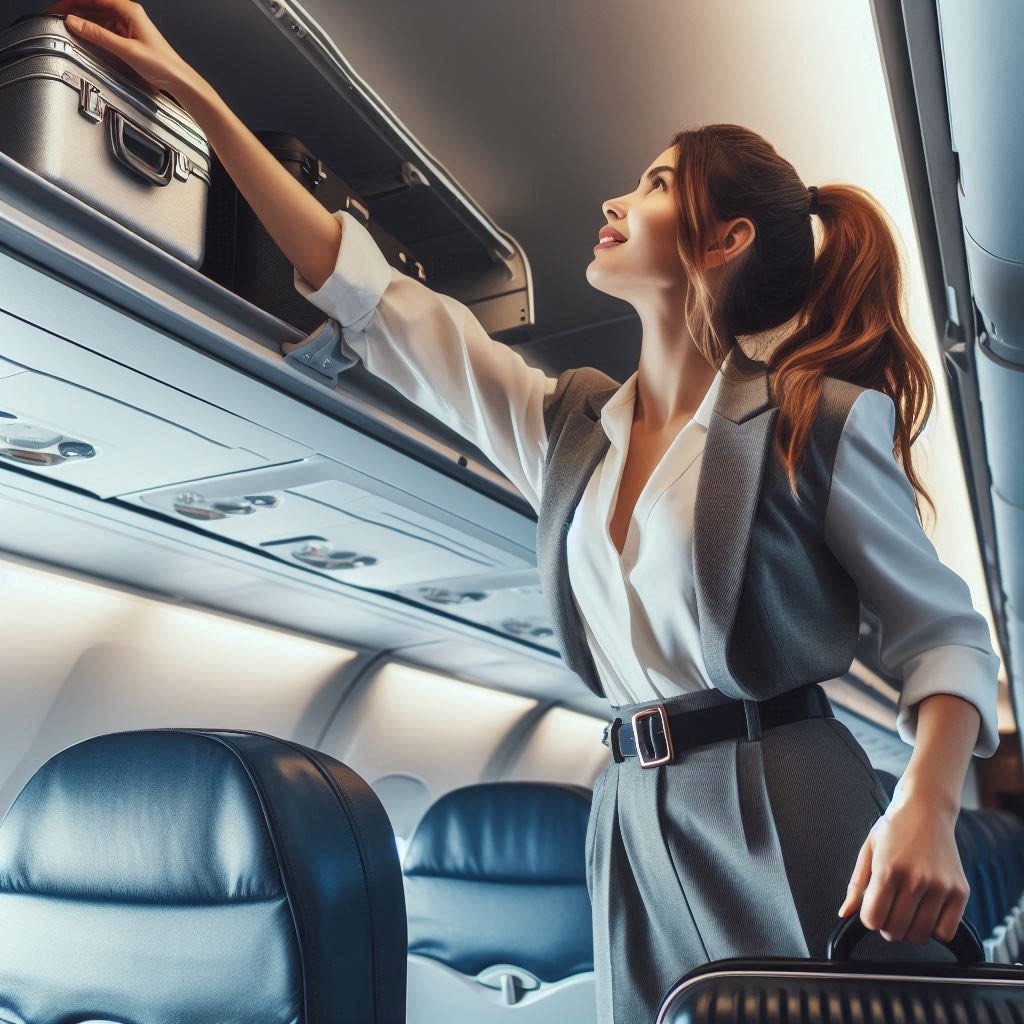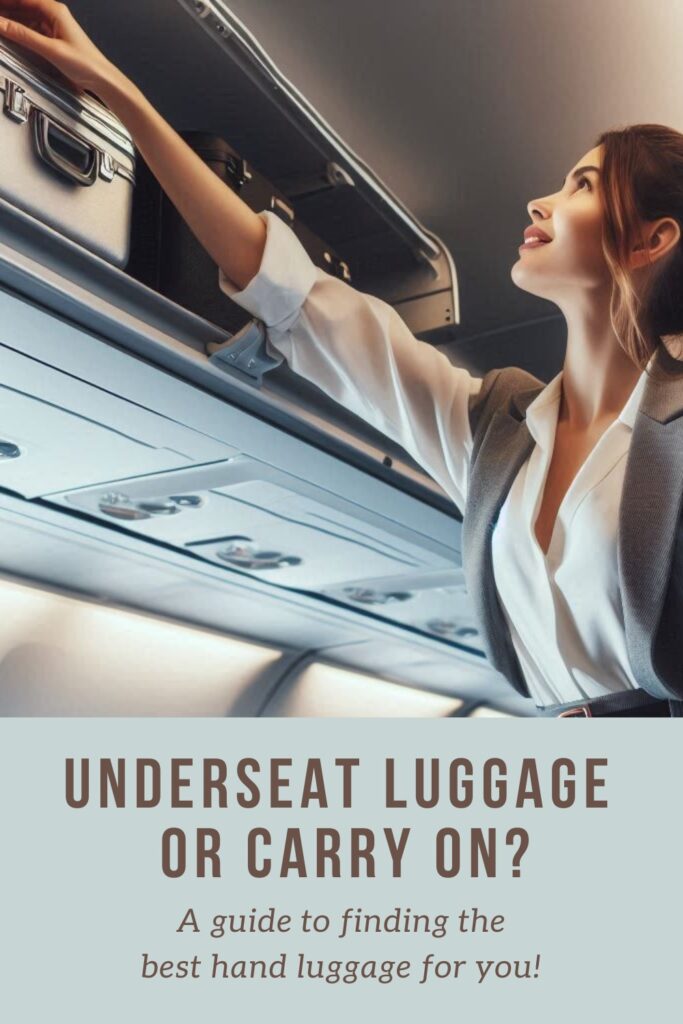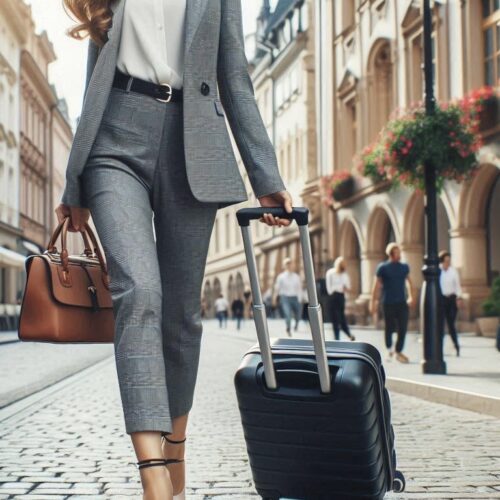Last updated on at 10:27 am
Planning a vacation to the charming small towns of Europe? Picture yourself wandering cobblestone streets, sipping espresso at quaint cafés, and marveling at centuries-old architecture. Sounds dreamy, right? But before you get to enjoy that, there’s the small matter of packing for your trip. Specifically, deciding between underseat luggage and traditional carry-on bags. Both have their perks and pitfalls, and making the right choice can set the tone for your entire journey. Let’s go into the pros and cons of each to help you decide which is right for you.

This post may contain affiliate links that may earn me a commission, at no additional cost to you, if you buy via them. As an Amazon Associate, I earn from qualifying purchases. Please see our Disclosure for more info.
What is Underseat Luggage?
Underseat luggage, as the name suggests, is designed to fit under the seat in front of you on an airplane. These bags are typically smaller than traditional carry-on bags and often come with clever organizational features to maximize space. They’re perfect for travelers who like to keep their essentials close at hand during the flight. But what makes them a real game-changer? Let’s break it down.
The Charm of Underseat Luggage
Pros of Underseat Luggage
1. Easy Access
One of the biggest advantages of underseat luggage is easy access to your belongings. Need your book, tablet, or a snack during the flight? No problem! You can reach down and grab it without contorting yourself into a pretzel or disturbing your fellow passengers. This is particularly handy on long flights where you might want to keep your entertainment, snacks, and personal items within arm’s reach. Not to mention, it saves you the awkward airplane yoga session of standing up and rummaging through the overhead bin while everyone watches.
Related Read: Long-Haul Flight – The Ultimate Survival Guide
2. Space Efficiency
Underseat luggage is a masterclass in space efficiency. These bags often come with multiple compartments, pockets, and sleeves, allowing you to pack smarter. Perfect for those who thrive on organization, you can keep your passport, travel documents, electronics, and personal items neatly sorted. It’s like having a mini dresser with you. Every item has its place, making it easier to find what you need without unpacking the whole bag. This organizational bliss is a lifesaver, especially when you’re trying to grab something quickly in the confined space of an airplane seat.
3. Avoid Overhead Bin Hassles
We’ve all been there—scrambling to find overhead bin space, only to realize they’re all full. With underseat luggage, this stress is a thing of the past. Your bag stays safely stowed right beneath you, eliminating the worry of finding space or having to gate-check your bag. This can be a huge relief, particularly if you’re flying on a busy route or during peak travel times. Plus, avoiding the overhead bins means you can board at your leisure without stressing about bin space.
4. Speedy Boarding and Disembarking
Since you’re not wrestling with overhead bins, you can board and disembark more quickly. This is a significant plus, especially if you have tight connections or simply want to get to your destination without the hassle of waiting. Think about it: while everyone else is fumbling with their bags, you’re already zipping out of the plane and on your way to the next adventure. It’s the little things that make travel smoother and more enjoyable.
Cons of Underseat Luggage
1. Limited Space
The most obvious downside is the limited space. Underseat luggage typically ranges from 15-20 inches in size, which means you’ll need to be a pro at packing light. If you’re the type who likes to bring a variety of outfit options or can’t live without multiple pairs of shoes, you might find this restrictive. You’ll have to be very selective with what you pack, often choosing multi-purpose items and cutting down on non-essentials. This can be a fun challenge for some, but a frustrating limitation for others.
2. Restricted to Smaller Items
Due to its size, underseat luggage is better suited for smaller items. If you need to carry bulky items like winter coats, larger toiletries, or souvenirs, you might struggle to fit everything in. For example, those beautiful hand-knitted sweaters from a local market or the extra pair of boots for your hiking adventures might not make the cut. This means you might have to make some tough decisions or find alternative ways to transport larger items.
3. Not Suitable for All Airlines
While most airlines allow underseat luggage, the dimensions of what is considered “underseat” can vary. Budget airlines, in particular, might have stricter size limits, so always check the airline’s guidelines before you pack. Imagine showing up with your perfectly packed underseat bag, only to find it doesn’t fit under the seat on your low-cost carrier. To avoid this, a little research goes a long way. Checking your airline’s specific requirements ahead of time can save you from unexpected hassles at the airport.
Related Read: Best Clothes to Travel on a Plane – Essential Items for Comfort and Style
The Traditional Carry-On Bag
Traditional carry-on bags are the stalwarts of air travel. Usually measuring up to 22 inches, they offer more space than underseat luggage and are typically stored in the overhead bin. Let’s take a closer look at why they remain a popular choice among travelers.
Pros of Carry-On Luggage
1. More Space
The most significant advantage is the extra space. With a traditional carry-on, you can pack more clothes, shoes, and other travel essentials. This makes it ideal for longer trips or those who simply need more room for their stuff. You can bring multiple outfit options, extra shoes, and even some creature comforts that make travel more enjoyable. For those who like to be prepared for every occasion or who find it hard to pack light, this added space can be a game-changer.
2. Versatility
Carry-on bags come in a wide variety of shapes and sizes, from hard-shell spinners to soft-sided duffels. This means you can choose one that best suits your travel style and packing preferences. Plus, many carry-ons come with expandable sections for those times when you pick up a few extra souvenirs. Whether you prefer the sleek look of a hard-shell or the flexibility of a soft-sided bag, there’s a carry-on to match your needs. The versatility extends to the types of trips as well, from business travel to family vacations.
3. Suitable for Most Airlines
Carry-on sizes are more standardized across airlines compared to underseat luggage. This means you’re less likely to run into issues with bag size, making it a more versatile option if you’re flying with multiple carriers. You can rest easy knowing that your carry-on will fit in the overhead bins on most flights, avoiding last-minute surprises at the gate. This standardization can make your travel experience smoother, especially if you’re hopping between different airlines.
Cons of Carry-On Luggage
1. Overhead Bin Wars
The biggest downside is the battle for overhead bin space. On crowded flights, finding room for your carry-on can be a challenge. If you’re among the last to board, you might end up having to gate-check your bag, which can be inconvenient. There’s nothing more frustrating than carefully packing your carry-on only to be told it needs to go in the hold because the bins are full. This can add time and stress to your journey, especially if you need quick access to your belongings upon landing.
2. Heavier and Bulkier
Carry-on bags, especially when fully packed, can be heavy and cumbersome to maneuver. This is something to consider if you have to navigate through crowded airports, cobblestone streets, or multiple flights of stairs in those charming European towns. Lugging a heavy carry-on up a narrow staircase in a historic hotel or through a bustling market can take away from the joy of your travels. It’s worth thinking about how much you’re willing to carry and how this might impact your mobility.
3. Slower Boarding and Disembarking
Dealing with overhead bins can slow down both the boarding and disembarking processes. If you’re in a hurry or have a tight connection, this can add unnecessary stress to your travel experience. While you’re waiting to retrieve your bag from the overhead bin, you might find yourself watching the minutes tick away, especially if you’re on a tight schedule. This can be particularly stressful during peak travel times when every second counts.
Which is Right for You?
Deciding between underseat luggage and a traditional carry-on largely depends on your travel needs and personal preferences. Let’s explore some scenarios to help you make the best choice.
Short Trips or Weekend Getaways
If you’re heading to Europe for a short trip or a weekend getaway, underseat luggage might be the perfect fit. The limited space encourages you to pack only what you need, and the convenience of having everything within reach can’t be overstated. Plus, navigating through airports and train stations is a breeze with a smaller, lighter bag. You can focus on enjoying your trip without worrying about lugging around a heavy suitcase. This simplicity can enhance the spontaneity and enjoyment of a short break, allowing you to make the most of every moment.
Longer Vacations or Business Trips
For longer vacations or business trips, a traditional carry-on might be more suitable. The extra space allows you to pack more outfits, shoes, and other essentials, which can be a lifesaver if you’re away for an extended period. Additionally, if you’re traveling for business, having a larger bag means you can pack professional attire without worrying about wrinkles or creases. This ensures you’re prepared for any situation, whether it’s a formal meeting or a leisurely day of sightseeing. The added space can also accommodate any unexpected purchases or gifts you might acquire during your trip.
Multi-Destination Travel
If your trip involves multiple destinations, underseat luggage can offer unparalleled convenience. Moving from city to city is much easier with a smaller bag, and you won’t have to worry about overhead bin space on each leg of your journey. However, if you’re carrying a lot of gear or planning to shop extensively, a carry-on might be the better choice. It’s a balancing act between mobility and capacity. Think about how often you’ll be moving and what you’ll need at each stop. For a whirlwind tour of Europe’s picturesque towns, the ease of underseat luggage might be worth the sacrifice in space.
Personal Travel Style
Your personal travel style also plays a significant role in this decision. If you’re a minimalist who thrives on packing light and staying organized, underseat luggage will likely suit you well. On the other hand, if you prefer to have a variety of clothing options and don’t mind the extra effort of dealing with a larger bag, a traditional carry-on is the way to go. Consider how you like to travel: Do you relish the challenge of packing light and efficiently, or do you feel more comfortable with a bit more space to play with? Your packing habits and travel preferences will ultimately guide you to the right choice.
Tips for Maximizing Your Packing Efficiency
No matter which type of luggage you choose, packing efficiently is key to a smooth travel experience. Here are some tips to help you make the most of your space:
1. Roll, Don’t Fold
Rolling your clothes instead of folding them can save space and reduce wrinkles. This technique is particularly useful for underseat luggage, where every inch counts. Rolled clothes can fit neatly into corners and crevices, making the most of your bag’s interior. Plus, it’s easier to see all your items at a glance, helping you stay organized and find what you need without unpacking everything.
2. Use Packing Cubes
Packing cubes are a game-changer for organization. They help keep your items neatly separated and can compress your clothing to save space. This is especially helpful for traditional carry-ons, where you might be packing more items. Packing cubes can transform the chaos of a fully-packed bag into an orderly system where everything has its place. They also make it easier to move items in and out of your bag, perfect for frequent travelers.
3. Choose Multi-Functional Items
Pack clothing and accessories that can serve multiple purposes. For example, a scarf can double as a blanket, and a pair of comfortable shoes can be worn for both sightseeing and casual dinners. Multi-functional items reduce the number of things you need to pack, saving space and making your bag lighter. Think about pieces that can be layered or dressed up and down, maximizing their utility throughout your trip.
4. Limit Toiletries
Most hotels and accommodations provide basic toiletries, so consider leaving these items at home. If you must bring your own, opt for travel-sized versions and use reusable containers to save space. Limiting toiletries not only saves space but also reduces the weight of your bag. Plus, it’s a good opportunity to try out local products at your destination, adding a little adventure to your travel routine.
5. Wear Your Bulkiest Items
If you’re bringing bulky items like a coat or boots, wear them during your travel day to free up space in your luggage. This is especially useful for underseat luggage, where space is at a premium. Wearing your bulkiest items also keeps you prepared for changes in weather and ensures you’re comfortable during your journey. It’s a practical way to maximize your packing efficiency while staying cozy on your flight.
6. Plan Your Outfits
Planning your outfits ahead of time can prevent overpacking. Choose versatile pieces that can be mixed and matched, and stick to a color scheme to maximize your options. By planning outfits, you ensure you have everything you need without bringing extra items “just in case.” This foresight helps you pack light and makes dressing each day straightforward, freeing up more time to enjoy your travels.
Final Thoughts
Whether you choose underseat luggage or a traditional carry-on, the most important thing is to find a solution that works for you and enhances your travel experience. Underseat luggage offers the convenience of easy access and a hassle-free boarding process, making it ideal for short trips and organized travelers. On the other hand, traditional carry-ons provide more space and versatility, making them perfect for longer vacations and those who like to pack a bit more.
Ultimately, your choice will depend on your travel plans, personal preferences, and packing style. Whichever option you choose, make sure to enjoy every moment of your trip to the beautiful small towns of Europe. Safe travels and happy packing!
FAQs
Is underseat luggage allowed on all airlines?
While most airlines allow underseat luggage, the size requirements can vary. It’s always best to check with your airline to ensure your bag meets their specifications. This can prevent any last-minute surprises at the gate and ensure a smooth boarding process. Always refer to the specific airline’s guidelines on their website or contact customer service if you’re unsure.
Can I fit a laptop in underseat luggage?
Yes, many underseat luggage options come with dedicated laptop compartments. However, it’s important to check the dimensions of the bag to ensure it can accommodate your laptop size. This feature is particularly useful for business travelers who need easy access to their devices during flights. Make sure your bag offers enough padding to protect your laptop and that the compartment is easily accessible.
How do I know if my carry-on will fit in the overhead bin?
Most airlines provide size guidelines for carry-on luggage. Measuring your bag and checking the airline’s requirements before you travel can help you avoid any issues at the gate. It’s a good idea to familiarize yourself with these standards, especially if you’re flying with multiple airlines. A little preparation can save you from the hassle of rearranging your belongings at the airport.
What if my underseat luggage is too big?
If your underseat luggage is too big, you might be asked to store it in the overhead bin or, in some cases, gate-check it. To avoid this, always check the size restrictions before you travel. Knowing your bag fits under the seat can give you peace of mind and ensure a smoother boarding experience. If you’re unsure, consider investing in a bag specifically designed to meet underseat dimensions.
Are there any weight limits for underseat luggage?
Weight limits for underseat luggage can vary by airline. Generally, there are no specific weight limits, but it’s a good idea to keep your bag as light as possible for ease of transport and to comply with overall carry-on weight restrictions. Overpacking can make your bag difficult to manage and might result in additional fees if it exceeds the airline’s limits. Staying within recommended weight guidelines ensures a hassle-free journey.
By understanding the benefits and limitations of both underseat luggage and traditional carry-on bags, you can make an informed decision that best suits your travel needs. Happy packing and bon voyage!
📌 Pin to Save 📌

Follow me on:




Just planning a trip with these questions in mind. Thanks for the tips!